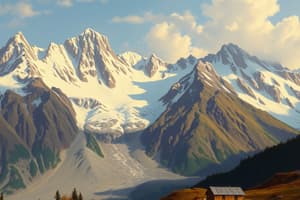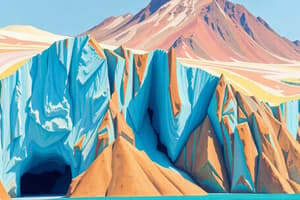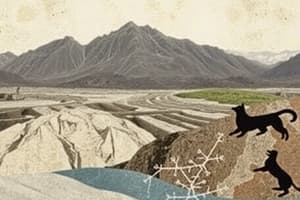Podcast
Questions and Answers
What significant cultural developments are associated with the Upper Paleolithic era?
What significant cultural developments are associated with the Upper Paleolithic era?
The Upper Paleolithic era is associated with advanced tools, art (like cave paintings), and complex social structures.
Describe the transition that occurred during the Mesolithic Era.
Describe the transition that occurred during the Mesolithic Era.
The Mesolithic Era saw a gradual shift from hunting and gathering to early agricultural practices.
What defines the Neolithic Era, and what changes did it bring about?
What defines the Neolithic Era, and what changes did it bring about?
The Neolithic Era is defined by the advent of agriculture, the domestication of animals, and the establishment of permanent settlements.
What characterizes the Neolithic Pre-Pottery Phase?
What characterizes the Neolithic Pre-Pottery Phase?
How did the Neolithic Pottery Phase contribute to advancements in technology and culture?
How did the Neolithic Pottery Phase contribute to advancements in technology and culture?
In what ways did hunting strategies evolve during the Upper Paleolithic?
In what ways did hunting strategies evolve during the Upper Paleolithic?
What role did trade play during the Upper Paleolithic and subsequent eras?
What role did trade play during the Upper Paleolithic and subsequent eras?
What is the significance of symbolic behavior in the context of the Mousterian tool culture?
What is the significance of symbolic behavior in the context of the Mousterian tool culture?
What is the difference between a glacier and an ice sheet?
What is the difference between a glacier and an ice sheet?
Define what a glacial advance is and its significance in the context of glaciation.
Define what a glacial advance is and its significance in the context of glaciation.
What are Milankovitch Cycles and how do they affect Earth's climate?
What are Milankovitch Cycles and how do they affect Earth's climate?
Explain the Ice-Albedo Effect and its impact on Earth's temperature.
Explain the Ice-Albedo Effect and its impact on Earth's temperature.
What characterizes an interglacial period, and how does it differ from a glacial period?
What characterizes an interglacial period, and how does it differ from a glacial period?
Identify what a glacial maximum is in geological terms.
Identify what a glacial maximum is in geological terms.
Discuss the implications of paleoclimate studies for understanding current climate change.
Discuss the implications of paleoclimate studies for understanding current climate change.
Summarize the significance of the Paleolithic Era in human history.
Summarize the significance of the Paleolithic Era in human history.
Flashcards
Glacier
Glacier
A large, slow-moving mass of ice formed from compacted layers of snow.
Glacial Period
Glacial Period
A time during which glaciers expanded significantly across the Earth.
Interglacial Period
Interglacial Period
A warmer phase between glacial periods when ice sheets retreat.
Paleoclimate
Paleoclimate
Signup and view all the flashcards
Milankovitch Cycles
Milankovitch Cycles
Signup and view all the flashcards
Ice Age
Ice Age
Signup and view all the flashcards
Solar Insolation
Solar Insolation
Signup and view all the flashcards
Glacial-Interglacial Cycles
Glacial-Interglacial Cycles
Signup and view all the flashcards
Upper Paleolithic
Upper Paleolithic
Signup and view all the flashcards
Mesolithic Era
Mesolithic Era
Signup and view all the flashcards
Neolithic Era
Neolithic Era
Signup and view all the flashcards
Neolithic Pre-Pottery Phase
Neolithic Pre-Pottery Phase
Signup and view all the flashcards
Neolithic Pottery Phase
Neolithic Pottery Phase
Signup and view all the flashcards
Mousterian tool culture
Mousterian tool culture
Signup and view all the flashcards
Early burials
Early burials
Signup and view all the flashcards
Symbolic behavior
Symbolic behavior
Signup and view all the flashcards
Study Notes
Glacial Features
- Glacier: A large, slow-moving mass of ice formed from compacted snow.
- Ice Sheet: A massive glacier covering a large land area (larger than a glacier, >50,000 sq km).
- Glacial Period: A time when glaciers expand significantly.
- Ice Age: A period with extensive ice sheets and glaciers.
- Glacial Advance: Glaciers growing and spreading.
- Glacial Retreat: Glaciers shrinking and moving back.
- Interglacial Period: Warmer periods between glacial periods, with ice sheet retreat.
- Paleoclimate: The study of past climates, including glacial and interglacial periods.
- Milankovitch Cycles: Cyclical changes in Earth's orbit impacting climate over thousands of years.
- Solar Insolation: The amount of solar energy Earth receives, affected by Milankovitch Cycles.
- Glacial-Interglacial Cycles: Recurring ice sheet advances and retreats, driven partly by Milankovitch cycles.
- Ice-Albedo Effect: Ice reflects solar radiation, cooling Earth; reduced ice cover leads to warming.
- Glacial Maximum: The point during a glacial period when ice sheets are largest.
- Geological Time Scale: A timeline of Earth's history, showing glaciation and interglacial periods.
Prehistoric Eras
- Paleolithic Era (Old Stone Age): From 2.5 million years ago to approximately 10,000 BCE, the earliest and longest human period. Marked by rudimentary stone tools, hunting/gathering, and early human societies.
- Lower Paleolithic (2.5 million to 300,000 years ago): Earliest Paleolithic; early humans (Homo habilis, Homo erectus) made simple stone tools (e.g., hand axes). Evidence of fire control and early social structures is present.
- Middle Paleolithic (300,000 to 40,000 years ago): More sophisticated stone tools (Mousterian tool culture); emergence of Homo neanderthalensis and early Homo sapiens; evidence of symbolic behavior and early burials show increasing complexity.
- Upper Paleolithic (40,000 to 10,000 years ago): Modern humans (Homo sapiens) develop advanced tools, art (cave paintings, carvings), and complex societies. Hunting strategies improved, long-distance trade, and structured dwellings emerged.
- Mesolithic Era (Middle Stone Age): Transitional period between the Paleolithic and Neolithic Eras (10,000-8,000 BCE); gradual shift to early agricultural practices; more specialized tools like microliths common.
- Neolithic Era (New Stone Age): Begins around 10,000 BCE, characterized by agriculture, animal domestication, permanent settlements, advancements in pottery and tool-making leading into social hierarchies and organized communities.
Neolithic Stages
- Neolithic Pre-Pottery Phase (10,000-7,000 BCE): Early settlement and farming; no pottery; stone tools, mud-brick structures; early experimentation with agriculture and animal domestication.
- Neolithic Pottery Phase (7,000-5,000 BCE): Widespread pottery use; pottery for both function and decoration; indication of advances in technology and culture; more complex communities with trade, social stratification, and specialized crafts.
Studying That Suits You
Use AI to generate personalized quizzes and flashcards to suit your learning preferences.




